
Cyclophora albipunctata, the birch mocha, is a moth of the family Geometridae. The species was first described by Johann Siegfried Hufnagel in 1767. It is found in the Palearctic. The southern boundary runs westward along the French Atlantic coast and to the British Isles and north of the Alps. In the east, the species ranges to the Pacific Ocean. South of the northern Alps line, it is found at some high elevation areas and mountains. In the Pyrenees, the Massif Central, the southern Alps, the northern Dinaric Alps, in the western and northern Carpathians, in northern Turkey and the Caucasus. In the north, the range extends up to the Arctic Circle. In the Far East the nominate subspecies is replaced by Cyclophora albipunctata griseolataStaudinger, 1897.

Cyclophora porata, the false mocha, is a moth of the family Geometridae. The species can be found in southern Europe and England to Denmark, southern Sweden and the Caucasus.

Cyclophora punctaria, the maiden's blush, is a moth of the family Geometridae. The species was first described by Carl Linnaeus in his 1758 10th edition of Systema Naturae. The species is mainly prevalent in Central and Eastern Europe. In the north, its distribution extends to southern Fennoscandia and the British Isles, in the west via France to parts of northern Spain, in the south via Italy, the Balkan Peninsula to Asia Minor. The eastern border of the distribution is roughly the Ural. In the Caucasus area, the nominate subspecies is replaced by the subspecies C. punctaria fritzae. The range of this subspecies extends as far as Iran.Cyclophora punctaria is found mainly in wooded areas with oak scrub and oak forests. In Central Europe it rises up to 700 metres in the hills, rarely up to 1,200 metres in the Alps, and regularly rises to 1,300 metres in southern Europe.

Cyclophora puppillaria, or Blair's mocha, is a moth of the family Geometridae. The species was first described by Jacob Hübner in 1799. It can be found in Europe and from North Africa up to the Caucasus area.
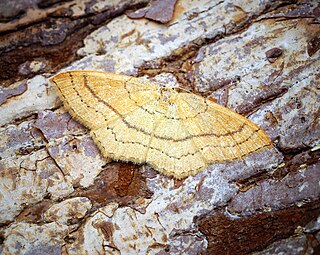
Cyclophora linearia, the clay triple-lines, is a moth of the family Geometridae. The species was first described by Jacob Hübner in 1799 and it can be found in Europe and Britain.

Cyclophora ruficiliaria, the Jersey mocha, is a moth of the family Geometridae. The species was first described by Gottlieb August Wilhelm Herrich-Schäffer in 1855. It can be found in Europe, in particular the Channel Islands as well as other parts of the mainland United Kingdom.

Cyclophora is a genus of moths in the family Geometridae. Many species are referred to as mochas in reference to their colouration, primarily in Europe.

Cyclophora nanaria, the dwarf tawny wave, is a moth of the family Geometridae. The species was first described by Francis Walker in 1861. It is found in the US from California to Texas and from New Jersey to Florida west along the Gulf Coast. The range extends south through Dominica and Jamaica to Argentina. It is an introduced species in Hawaii.

Cyclophora obstataria is a moth of the family Geometridae first described by Francis Walker in 1861. It is known from the Indian subregion, Sri Lanka and China to Sundaland, New Guinea and Queensland in Australia.
Otitoma is a genus of sea snails, marine gastropod mollusks in the family Pseudomelatomidae.
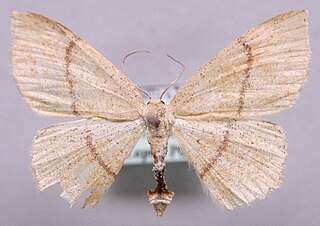
Cyclophora quercimontaria is a moth of the family Geometridae. It is found from southern Scandinavia to central and southern Europe and from western Russia to the Caucasus, northern Iran and the northern parts of Asia Minor.
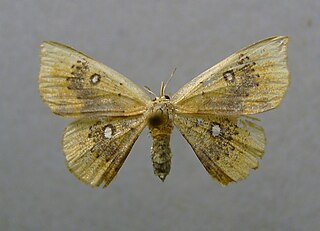
Cyclophora albiocellaria is a moth of the family Geometridae. It is found in south-eastern Europe and parts of Central-Asia.
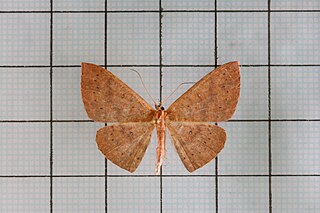
Cyclophora intermixtaria is a moth of the family Geometridae first described by Charles Swinhoe in 1892. It is found in Taiwan, the Himalayas, Peninsular Malaysia and Borneo.

Cyclophora lennigiaria is a moth in the family Geometridae. It is found in south-western Europe, north to southern France and western Germany, as well as in Morocco.
Cyclophora suppunctaria is a moth in the family Geometridae. It was described by Philipp Christoph Zeller in 1847. It is found in Spain, Andorra, France, Austria, Switzerland, Italy, Slovakia, Albania, Slovenia, Croatia, Bulgaria, Romania, Hungary, North Macedonia, Greece, on Sardinia, Corsica, Sicily and Crete, as well as in Tunisia, Turkey, Russia and Ukraine.
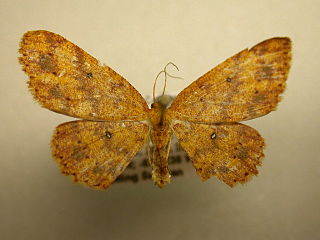
Cyclophora aurantiata is a moth in the family Geometridae. It is found in Peru and Costa Rica.
Cyclophora auricosta is a moth in the family Geometridae. It is found in New Guinea.
Cyclophora binocellaria is a moth in the family Geometridae. It is found in Venezuela and Bolivia.
Cyclophora bipartita is a moth in the family Geometridae. It is found in Colombia and Peru.














